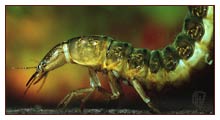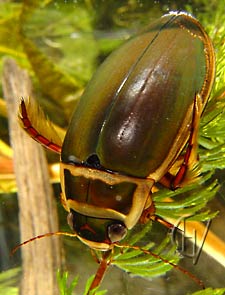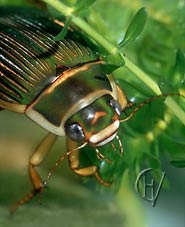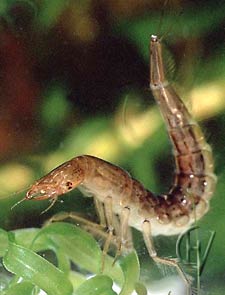Dytiscus marginalis - the Great diving beetle
Click on one of the pictures for a larger picture.
On the left a picture of a male Great diving beetle, in a resting pose under water. The breathing opening at the hind tip of the abdomen is closed because the beetle has pressed that tip tightly to the elytra, the wing cases that cover the back. The border of the air supply, closed in under the elytra, gives the tip a a silver seam. Like most water insects, the Great diving beetle needs to come up for a new supply of fresh air. This air is taken in by bringing the tip of the abdomen to the water surface and then lowering it. The male is recognizable by its smooth wing cases, as opposed to the grooved ones of the female. However, some females do have smooth wing cases too. But the females never have the sucking disks on the front legs that the males have. The male need these to get a firm grip on the slippery prothorax of the female when mating. More difficult to see is the difference in the fringes of swimming hairs on the hind legs: the males have these on two sides of these legs, the females only on one side.
The picture on the right shows a female specimen. The grooves in the elytra are clearly visible. The grooves end at a distance before the apex, so the end part is not grooved but flat. The reason why the females have these grooves is not known. The females of the Lesser diving beetle, Acilius sulcatus, also have a corrugated wing case. One suggested explanation is the male could have more grip on the ribbed surface, but in reality the sucker discs of the male provide the necessary hold, furthermore they attach to the pronotum, never to the elytra. The beetles are able to fly well: on evenings with little wind they climb out of the water and sit in a rather upright position on their legs. Then a strange high pitched humming is produced: possibly the pumping of air in the hollow veins of the second pair of wings (with which they fly), and in the body. Suddenly they take off, buzzing like a giant lady beetle. After a while flying they dive down when they spot a shining surface which may be a pond, but also swimming pools, the glass of breeding houses, shining cars or newly tarred roofs. They are also attracted at night by light sources, for example street lamps or doorlights of houses. And thus, it has become more and more a dangerous flight for the beetle in the last decades, with all these confusing unnatural traps. In spring, if the female beetle has found a ditch or pond that has enough water plants and food supply, she cuts holes in the stems of some species of water plants with her ovipositor, a sort of injection needle for eggs at the tip of her abdomen, and lays an egg in every hole. In that way the elongated, cylindrical eggs are stowed out of sight. Then after a few days, small translucent larvae suddenly appear everywhere in the water.
the Larva
The swarming newborn little larvae look like defenceless micro-shrimps - and indeed their numbers shrink rapidly, because they are a much appreciated snack for other insects and fishes. But they are little predators themselves: barely hatched, they catch and devour smaller creatures, or even each other, if they get the chance. They moult a few times and grow at an astonishing rate. The shape of each larva becomes apparent: a slim, glassy caterpillar with six, long legs and two terrifying, sickle-shaped jaws: a deadly pair of pincers, with which the larva snaps its prey. Lots of prey, because it must grow fast: the larva is even more voracious then the adult beetle. In the picture at left: a specimen which is still only about two centimeters, sitting in the typical posture of the Dytiscus larva: tail bend upward, body curved in an "S" (or question mark) shape. The larva is lighter than water most of the time, because of the air it inhaled. So when letting go of its hold, the larva slowly rises to the surface, with its legs paddling faintly to keep balance. At the moment the tip of the tail pierces the surface film, two small holes open, which are the ends of the main airducts (trachea). These airducts are now ventilated by breathing movements of the body. Two small appendages at the tail (cerci) support the upright position of the tail against the surface film. The larva spends a lot of time "hanging" like this at the surface, waiting seemingly lifeless for bait to pass by. But when a small fish, tadpole or insect comes near, the larva is suddenly very attentive: like a snake, it bends its body backwards for the attack, the jaws standing wide open. When the prey reaches the target point, the larva snatches it with a lightning fast pouncing movement of the head. The animal it caught is dangling, pierced between the sickle-shaped jaws, the sharp tips almost meeting in the victims body. Then a gruesome, but fascinating spectacle follows: a brown fluid is injected through the hollow jaws into the prey, that ends its violent struggling after a few seconds, because of the poisonous effect. The fluid contains protein-dissolving enzymes that liquifies the interior of the bait. The fluid is sucked back in, together with the dissolved nutrients. This process is repeated continuously, the streaming of the fluid is clearly visible in the jaws and in the head, where the streams come together in one duct: the digestive canal. So the the first digestion is external. After an hour or less, most preys are sucked completely empty, a skin or external skeleton is all that remains of even the fattest caddis fly larva. The larva drops the rest and after that is ready for the next catch, the jaws again opened wide. It doesn't hesitate in attacking prey larger than itself, and won't let go, even if it is dragged through the water by the agonised victim .

Dytiscus marginalis
larva, last instar
After each moult the larva expands to one-and-a-half its former size until it is about six centimeters long.The full grown larva is fat and heavy, it doesn't hang from the surface anymore, but chooses shallow water where it still can get its tail tip in contact with the air. At last it stops eating and leaves the water. It than digs a small hole in the mud, on the shore where it pupates. After a few weeks the beetle bursts out of the pupal skin. It first is still white and soft, so it has to stay in the pupation hole a few days to harden, during which the colour also turns dark.
MAIN Index Beetles1 Beetles2 Bugs1 Bugs2 Dragonflies Other insects, spiders Other animals
back to WATERBEETLES 1
Deze pagina in het Nederlands
COPYRIGHT:
rev. 01-03-2024


